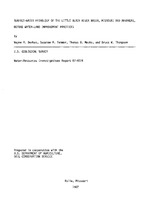Surface-water hydrology of the Little Black River basin, Missouri and Arkansas, before water-land improvement practices
Links
- Document: Report (pdf)
- NGMDB Index Page: National Geologic Map Database Index Page (html)
- Download citation as: RIS | Dublin Core
Abstract
The U. S. Department of Agriculture, Soil Conservation Service, in accordance with Public Law 566, is implementing various types of water-land improvement practices in the Little Black River basin in southeastern Missouri. These practices are designed, in part, to decrease the suspended sediment (SS) transport in the basin, decrease flood damage in the basin, and improve drainage in the agricultural area. The general features of the basin, such as geology, groundwater hydrology, soils, land use, water use, and precipitation are described; surface water quantity, quality, and suspended sediment discharge are also described. The aquifers are the Mississippi River valley alluvial aquifer, which can yield about 3,500 gal/min to properly constructed wells, and the Ozark and St. Francois aquifers, which can yield from about 30 to 500 gal/min to properly constructed wells. Soils in the area have formed in loess and cherty residuum in the uplands or have formed in alluvial sediment in the lowlands. About 93% of the estimated 3 billion gal/year of water used in the basin is for crop irrigation. The average monthly precipitation varies slightly throughout the year, with an average annual precipitation of about 47 inches. Water quality data were collected at seven stations. Specific conductance values ranged from 50 to 400 microsiemens/cm at 25 C. Water temperatures ranged from 0.0 C in the winter to 33.5 C in summer. pH values ranged from 6.4 to 8.5 units. Dissolved oxygen concentrations ranged from 2.2 to 12.8 ml/l. Total nitrogen concentrations ranged from 0.13 to 2.20 ml/l as nitrogen, with organic nitrogen as the most abundant form. Phosphorus concentrations ranged from zero to 0.29 ml/l as phosphorus. Bacterial counts were largest during storm runoff in the basin with livestock waste as the significant contributor. For the period from October 1, 1980, to September 30, 1984, the average annual SS discharge ranged from 2,230 tons/yr in the headwater areas to 27,800 tons/yr at the most downstream station. The average annual SS yield ranged from 59.6 to 85.9 tons/sq mi.
Study Area
| Publication type | Report |
|---|---|
| Publication Subtype | USGS Numbered Series |
| Title | Surface-water hydrology of the Little Black River basin, Missouri and Arkansas, before water-land improvement practices |
| Series title | Water-Resources Investigations Report |
| Series number | 87-4076 |
| DOI | 10.3133/wri874076 |
| Year Published | 1987 |
| Language | English |
| Publisher | U.S. Geological Survey |
| Contributing office(s) | Missouri Water Science Center |
| Description | ix, 54 p. |
| Country | United States |
| State | Arkansas, Missouri |
| Other Geospatial | Little Black River basin |


